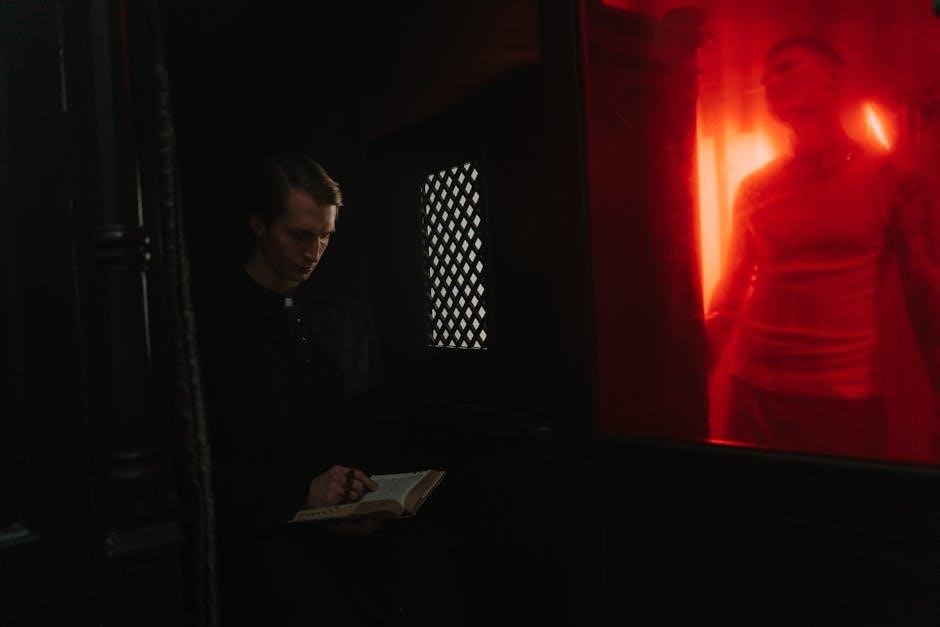list of types and shadows in the bible pdf
Biblical types and shadows are symbolic representations in the Old Testament that prefigure New Testament truths, revealing deeper spiritual realities through people, events, and objects, enriching our understanding of redemption and divine plans.
1.1 What Are Types and Shadows?
Types and shadows in the Bible are prefigurations or foreshadowings of future events, persons, or spiritual truths. They are often symbolic representations or prototypes that point to greater realities fulfilled in Christ or the Church. A “type” refers to a person, event, or object in the Old Testament that serves as a model or anticipation of a New Testament counterpart. A “shadow” is a temporary representation of a permanent spiritual reality, such as the tabernacle symbolizing God’s presence. These concepts are rooted in biblical prophecy and symbolism, offering deeper insights into God’s plan of redemption. By studying types and shadows, believers can better understand the unity and progression of Scripture, as well as the fulfillment of divine promises in Christ. This method of interpretation enriches one’s understanding of biblical themes and spiritual truths.
1.2 Importance of Studying Biblical Typology

Studying biblical typology is essential for gaining a deeper understanding of Scripture and its unified message. Types and shadows reveal the progressive nature of God’s revelation, showing how the Old Testament prepares for the New Testament’s fulfillment in Christ. This study enhances worship by unveiling the richness of God’s plan and the harmony of His Word. It also strengthens faith by demonstrating the consistency and purposefulness of divine redemption. Additionally, typology provides practical lessons for Christian living, as earthly examples illustrate spiritual truths. By exploring these connections, believers can better appreciate the Bible’s coherence and the ultimate fulfillment of all things in Christ. This study is a powerful tool for maturing in faith and applying biblical principles to everyday life.
Understanding Biblical Typology
Biblical typology reveals connections between the Old and New Testaments, showing God’s plan unfolding. It aids in interpreting Scripture, deepening faith by highlighting Christ’s fulfillment of types.
2.1 Definition and Scope of Typology
Biblical typology is the study of types (prefigurations) and shadows (foreshadows) in Scripture, where people, events, or institutions in the Old Testament prefigure truths in the New Testament. These types are not random but are intentionally designed by God to reveal His plan of redemption; The scope of typology extends across the entire Bible, with examples such as Adam foreshadowing Christ, the Passover symbolizing salvation, and the Tabernacle representing God’s presence among His people. Typology reinforces the unity of Scripture, demonstrating how the Old Testament points to the fulfillment in Jesus Christ. It serves as a powerful tool for deeper understanding, connecting historical events to spiritual truths.
2.2 Role of Typology in Interpreting Scripture
Biblical typology plays a crucial role in interpreting Scripture by revealing how Old Testament events, people, and institutions foreshadow New Testament truths. It helps believers understand the unity of God’s Word, showing how earlier revelations anticipate later fulfillments. Typology enriches biblical interpretation by connecting historical narratives to spiritual realities, such as seeing Christ as the ultimate fulfillment of Old Testament types; This approach prevents misinterpretation by emphasizing the symbolic and prophetic nature of certain passages. It also deepens devotion by highlighting God’s consistent plan of redemption. By studying typology, readers gain a deeper appreciation for the Bible’s coherence and the divine design woven throughout its pages.

2.3 Connection Between the Old and New Testaments
The Old and New Testaments are intricately connected through typology, with the Old Testament laying the foundation for the fulfillment revealed in the New. Types and shadows in the Old Testament foreshadow key aspects of Christ’s ministry, such as His sacrifice, priesthood, and kingdom. For example, the Passover lamb symbolizes Christ’s atonement, while the tabernacle represents God’s dwelling among His people, culminating in the Church. This connection emphasizes God’s cohesive plan of redemption, demonstrating how the Old Testament anticipates the New. Understanding these links deepens one’s appreciation for the unity of Scripture and the fulfillment of God’s promises through Jesus Christ.

Key Principles for Interpreting Types and Shadows
Typology uncovers deeper truths in Scripture. Careful interpretation is essential to avoid misapplication, ensuring symbols align with their intended meanings and purposes.
3.1 Biblical Confirmation of Types and Shadows
Biblical confirmation is vital for authentic interpretation. The New Testament often clarifies Old Testament types, like Jesus as the bronze serpent or the Tabernacle symbolizing His presence. Contextual study ensures meanings align with Scripture, avoiding extreme or personal interpretations. Historical insights from scholars and Church Fathers provide reliable guidance, enhancing understanding while maintaining biblical integrity. Praying for the Holy Spirit’s illumination aids in grasping these symbolic connections, ensuring they reflect the Bible’s intended message rather than individual conjecture. This balanced approach honors the text’s authority, preventing misapplication and fostering a deeper appreciation of typology.

3.2 Consistency with the Rest of Scripture
Interpreting types and shadows requires consistency with the rest of Scripture to avoid misapplication. Biblical typology must align with the overall message and themes of the Bible, ensuring that symbols and foreshadowing do not contradict other teachings. For example, the Passover lamb in Exodus prefigures Christ’s sacrifice, a connection confirmed in John 1:29. Such interpretations must harmonize with the New Testament’s revelation of Jesus Christ. Avoiding isolated or contradictory views ensures that typology enriches understanding without distorting the biblical narrative. This approach safeguards the integrity of Scripture, preventing interpretations from becoming speculative or detached from the Bible’s central message of redemption and God’s plan of salvation.
3.3 Avoiding Extreme Interpretations
When studying types and shadows, it is crucial to avoid extreme interpretations that distort the Bible’s intended meaning. While typology reveals profound connections, it must remain grounded in Scripture. Over-speculation or forcing symbols beyond their clear biblical context can lead to error. For instance, seeing every object as a type of Christ or over-allegorizing can obscure the text’s literal meaning. A balanced approach ensures that typology enhances, rather than complicates, understanding. By staying within the bounds of biblical clarity and avoiding fanciful connections, believers can appreciate the richness of typology without losing sight of its foundational truths. This guards against misinterpretation and keeps the focus on God’s redemptive plan revealed throughout Scripture.
Major Types of Christ in the Old Testament
The Old Testament contains numerous types and shadows that foreshadow Christ’s role as a sacrifice, priest, and redeemer. Figures like Adam, Melchizedek, Joseph, and the Tabernacle symbolize aspects of His ministry, providing a rich tapestry of divine revelation that points to the Messiah.
4.1 Adam: The First and Last Adam
Adam, as the first man, serves as a significant type of Christ, often referred to as the “Last Adam.” Created in God’s image, Adam represents humanity’s original purity and divine connection. His disobedience in the Garden of Eden introduced sin, while Christ, through His obedience, reversed this curse. In 1 Corinthians 15:45, Paul contrasts Adam as a “living being” with Christ as a “life-giving Spirit,” highlighting their distinct roles. Adam’s sin brought death, but Christ’s sacrifice brought eternal life. This typology underscores the redemptive plan of God, where Christ restores what was lost through Adam. The parallel between the first and last Adam reveals God’s intention to redeem humanity through the perfect obedience of His Son.
4.2 Melchizedek: The Eternal Priest
Melchizedek, the enigmatic figure in Genesis 14:18-20, serves as a powerful type of Christ as the Eternal Priest. His name, meaning “King of Righteousness,” symbolizes his dual role as both king and priest, foreshadowing Christ’s reign and priesthood. Appearing without a genealogy, Melchizedek receives a tithe from Abraham, signifying recognition of his divine authority. The Apostle Paul in Hebrews 5:6 and 7:1-3 links Melchizedek to Christ, emphasizing His eternal priesthood. Unlike earthly priests, bound by lineage, Melchizedek’s priesthood is timeless, mirroring Christ’s unending intercession. This typology highlights Christ’s supremacy as the ultimate Priest-King, offering redemption and eternal life. Melchizedek’s ministry prefigures Christ’s, illustrating God’s redemptive plan through an eternal priesthood.
4.3 Joseph: A Shadow of Christ’s Ministry
Joseph, a prominent figure in Genesis, serves as a remarkable shadow of Christ’s ministry. His life mirrors Christ’s journey, from being a favored son to facing betrayal and suffering. Like Christ, Joseph was unjustly rejected by his own (Genesis 37:23-24), symbolizing the rejection of Jesus by His people. Joseph’s suffering and subsequent elevation to a position of power (Genesis 41:39-40) foreshadow Christ’s death, resurrection, and exaltation. Both provided sustenance in times of famine—Joseph physically and Christ spiritually. Joseph’s forgiveness of his brothers (Genesis 45:14-15) reflects Christ’s grace and mercy. These parallels highlight Joseph as a type of Christ, illustrating redemption, divine sovereignty, and the ultimate triumph of God’s plan through suffering and forgiveness.
4.4 The Tabernacle: A Symbol of God’s Presence
The Tabernacle, constructed according to God’s detailed instructions, serves as a profound type and shadow of God’s presence among His people. Its design, from the outer court to the Holy of Holies, symbolizes the progressive revelation of God’s nature and humanity’s access to Him. The Ark of the Covenant, housed in the Holy of Holies, represented God’s throne and His covenant with Israel. The Tabernacle’s veils and furnishings, such as the altar of incense and the menorah, foreshadowed Christ’s ministry as the ultimate High Priest and the light of the world. The tearing of the temple curtain at Christ’s death symbolized the fulfillment of the Tabernacle’s purpose, granting believers direct access to God’s presence through Him.

Shadows of the Church in the Old Testament
The Church is foreshadowed in the Old Testament through Israel, the tabernacle, and the priesthood, symbolizing God’s dwelling among His people and believers’ spiritual roles.
5.1 Israel as the Bride of God
Israel is portrayed as the “bride of God” in the Old Testament, symbolizing a sacred covenant relationship. This typology is deeply rooted in biblical history, as seen in Hosea 2:19-20, where God betroths Himself to Israel, and in Ezekiel 16, which describes Jerusalem as a bride adorned for her husband. The marriage covenant between God and Israel foreshadows the New Testament’s depiction of the Church as the Bride of Christ (Revelation 19:7-8). Israel’s journey, including her redemption from Egypt and wilderness wanderings, serves as a shadow of the spiritual journey of believers, emphasizing themes of covenant faithfulness, divine love, and ultimate union with God. This typology underscores the profound spiritual lessons of God’s relationship with His people, both historically and eschatologically.
5.2 The Tabernacle as a Type of the Church
The Tabernacle, described in Exodus, serves as a profound type of the Church. Its design and purpose symbolize the spiritual realities of the Church as the dwelling place of God. The Tabernacle’s materials and craftsmanship represent the purity and unity of believers, while its structure—outer court, Holy Place, and Holy of Holies—reflects the progression of God’s presence among His people. In the New Testament, the Church is described as the “temple of God” (1 Corinthians 3:16-17), with believers as “living stones” (1 Peter 2:5). The Tabernacle’s veil, torn at Christ’s crucifixion, symbolizes access to God’s presence through Him. This typology emphasizes the Church’s role as a spiritual sanctuary, where God dwells among His people, fulfilling the shadow of the Old Testament Tabernacle.
5.3 The Priesthood and the Believer’s Role
The priesthood in the Old Testament, particularly the Levitical priesthood, serves as a type of the believer’s role in the Church. The priests were mediators, offering sacrifices and representing the people before God. In the New Testament, Jesus Christ is revealed as the ultimate High Priest, offering Himself as the perfect sacrifice (Hebrews 7-10). This fulfillment transitions the priesthood from a select group to all believers, who are now called a “royal priesthood” (1 Peter 2:9). Believers are empowered to offer spiritual sacrifices, such as praise, thanksgiving, and good works, directly to God. This understanding transforms the Church into a body of priests, united in worship and service, reflecting the unity and purpose of the original priesthood.

Antitypes and the Antichrist
Antitypes are fulfillments of biblical types, often symbolizing the ultimate adversary. Figures like Cain and Judas foreshadow the Antichrist, embodying rebellion and opposition to God’s plan.
6.1 Cain: A Type of Deception
Cain, the firstborn of Adam and Eve, represents a significant antitype in biblical typology, symbolizing deception and rebellion against God. His offering, rejected by God, reflects a lack of faith and improper worship. Cain’s jealousy toward Abel, leading to his brother’s murder, exemplifies the spirit of hatred and deceit. This act of violence introduces the concept of sin’s consequences and the emergence of evil in humanity. Cain’s descendants, notably Lamech, further perpetuate a lineage of wickedness and pride. Biblically, Cain’s actions foreshadow the Antichrist’s deceptive nature and opposition to God’s truth. His story serves as a warning against self-righteousness and the dangers of rejecting divine counsel, highlighting the importance of humility and obedience to God’s will.

6.2 Judas Iscariot: Betrayal and Rejection
Judas Iscariot, one of Jesus’ twelve apostles, serves as a profound antitype of betrayal and rejection. His infamous act of betraying Jesus for thirty pieces of silver symbolizes the ultimate rejection of God’s truth. Judas’s actions, driven by greed and deceit, parallel the spiritual betrayal of those who reject Christ. His kiss of betrayal in the Garden of Gethsemane signifies hypocrisy and false allegiance. Despite being chosen by Jesus, Judas’s heart remained hardened, illustrating the dangers of unrepented sin. His tragic end, marked by remorse and suicide, serves as a cautionary tale of the consequences of spiritual rebellion. Judas’s story highlights the themes of rejection, betrayal, and the fulfillment of prophecy, offering a stark contrast to the redemption offered through Christ.
6.3 Other Shadows of the Antichrist
Beyond Cain and Judas, the Bible highlights other figures who serve as shadows or types of the Antichrist. Balaam, a prophet-for-hire, exemplifies the spirit of antichrist through his greed and willingness to curse God’s people, mirroring the Antichrist’s opposition to God. Antiochus Epiphanes, a historical figure, desecrated the Temple and blasphemed God, foreshadowing the Antichrist’s abomination of desolation. Similarly, the Assyrian king Sennacherib’s pride and defiance against God reflect the Antichrist’s arrogant rebellion. These shadows emphasize the recurring theme of opposition to God’s authority, preparing believers to recognize and resist the ultimate Antichrist. Each example underscores the importance of spiritual discernment and loyalty to God’s truth in the face of deception and rebellion.

The Rapture and End-Time Events
The Rapture represents the sudden departure of believers, paralleled by Enoch’s translation without death. Elijah’s fiery ascent symbolizes glorified departure, prefiguring end-time events and Christ’s return.
7.1 Enoch: A Type of the Rapture
Enoch’s translation without experiencing death (Genesis 5:24) serves as a powerful type of the Rapture. His sudden removal from the earth mirrors the believer’s future escape from the tribulation. Enoch’s walk with God and his faithfulness demonstrate the qualities required for believers to be “caught up” in the Rapture (1 Thessalonians 4:17). His life exemplifies the hope of believers being transformed and taken to heaven without facing death. This typology emphasizes God’s desire to deliver His people from judgment, highlighting the Rapture as a divine act of mercy and redemption. Enoch’s story encourages believers to live with anticipation and readiness for Christ’s return.
7.2 Elijah: A Shadow of Glorious Departure
Elijah’s miraculous ascension in a chariot of fire (2 Kings 2:11-12) is a shadow of the glorious departure believers anticipate in the Rapture. His translation, without experiencing death, symbolizes the supernatural nature of the Rapture. Elijah’s life of faithfulness and his role as a prophet foreshadow Christ’s second coming. The fiery chariot represents divine judgment and deliverance, paralleling the ultimate rescue of believers from earthly tribulation. Elijah’s departure also highlights the sudden and glorious manner in which believers will be transformed and caught up to meet the Lord. This shadow reinforces the hope of believers in their future glorification and the divine plan of redemption.
7;3 The Day of the Lord and Divine Judgment
The Day of the Lord, a recurring theme in biblical prophecy, serves as a shadow of end-time divine judgment. It is depicted as a time of reckoning, often associated with darkness, trembling, and the unveiling of God’s wrath (Joel 2:31, Amos 5:18-20). This imagery foreshadows the final judgment where all humanity will stand before God. The Old Testament describes the Day of the Lord as a purifying fire, cleansing creation of sin. It parallels the ultimate judgment Christ will execute at His second coming (2 Thessalonians 1:7-10). The biblical types emphasize God’s justice, mercy, and the necessity of spiritual preparedness. These shadows remind believers of the urgency to repent and align with God’s will, reflecting the eternal consequences of divine judgment.

Applying Typology to Christian Life
8.1 Spiritual Growth Through Typology
Spiritual growth through typology involves gaining deeper insights into God’s plan by studying biblical types and shadows. These symbols reveal Christ’s nature, redemptive work, and the believer’s role in God’s kingdom. By understanding how Old Testament figures like Adam, Joseph, and the Tabernacle foreshadow Christ, believers can strengthen their faith and grasp the unity of Scripture. Typology also provides practical lessons, such as humility, obedience, and trust, which are essential for maturing in Christ. It fosters a greater appreciation for God’s sovereignty and grace, enabling believers to live more purposefully and worshipfully. Ultimately, typology transforms the Christian life by illuminating spiritual truths and drawing believers closer to God.
8.2 Practical Lessons from Biblical Types
Exploring biblical types and shadows offers practical lessons for Christian living. For instance, Joseph’s life teaches forgiveness, humility, and divine providence, while Moses exemplifies leadership and meekness. The Tabernacle symbolizes God’s desire for fellowship and the believer’s role as a living temple. David’s life highlights repentance and God’s mercy, showing the importance of a contrite heart. Even the Prodigal Son story reflects God’s grace and the joy of restoration. These typological lessons guide believers in navigating life’s challenges, fostering obedience, and deepening their relationship with God. By applying these truths, Christians can live more faithfully, trusting in God’s sovereignty and grace in everyday circumstances.